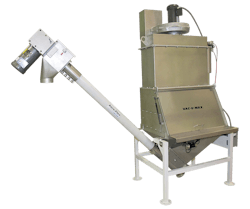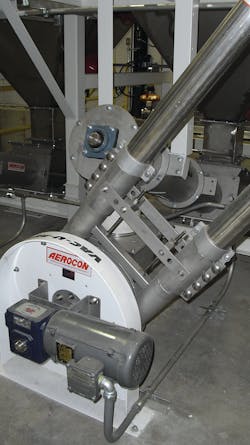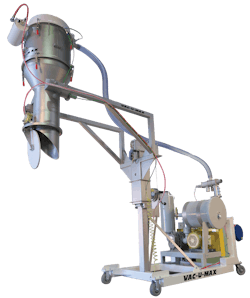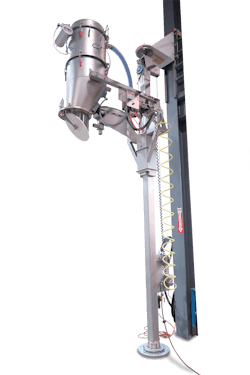Cost considerations with aero-mechanical and vacuum conveying
Handling powder and bulk solids is a specialized field with no two conveying applications quite the same. Although two manufacturers might use the same material as one another, utilize similar types of equipment or have similar processes, factors unique to each manufacturing line and organization require considerations distinctive to that process. For one manufacturer, a vacuum conveying system may be the solution. But for the other, an aero-mechanical conveyor may offer the best solution to meet needs and objectives.
Both vacuum conveying and aero-mechanical conveying are enclosed conveying systems designed to transfer powders gently and safely. Whether employing automated powder transfer systems to increase plant safety, meet strict food and pharmaceutical regulations, comply with respirable and combustible dust regulations, or to increase throughput to meet increased demand, costs weigh heavily in the purchase decision.
Expert conveyor manufacturers with experience designing both vacuum conveying and aero-mechanical conveying systems help processors and manufacturers weigh upfront cost, system benefits and down-the-line costs including maintenance, utility usage, cleaning, downtime and safety savings between both systems.
A standard conveying system consists of five basic pieces of equipment that come together to work as one — a pick-up point, convey tubing, a vacuum receiver, a vacuum producer and a control module. From the pick-up point, material flows through convey tubes to the vacuum receiver, which transfers material from above process or packaging machinery through discharge valves on the bottom of the receiver. Vacuum producers are the core of pneumatic conveying systems and work with the control panel to manage the flow of material through the convey tubes to the vacuum filter receivers.
Aero-mechanical conveying consists of two parallel tubular housings, typically 3- or 4-inch tubes, containing a continuous loop of steel cable. Polymer discs, smaller than the inside of the diameter of the tubes, are mounted at equal intervals along the steel cable. One side of the housing is for conveying and the other is for return. Material inlet and outlets are suitably located for the application. A small 2hp or 3hp motor provides drive to one of two sprocket assemblies, and another guides the return. Material entering the inlet is moved in a fluidized form, by pockets of air between the discs, further aided mechanically by movement of the discs to the outlet or discharge point.
Both systems are dust-free solutions to open conveying and manual powder transfer, and each has its strengths.
Energy costs
Aero-mechanical conveying has the ability to move large amounts of material with minimal energy consumption because there is only a small motor driving the sprocket assembly. Moving at rates of 750 feet per minute, the sprocket assembly creates its own airflow, cycling any leftover material through the enclosed tubular housing until it discharges through the outlet, which eliminates the need for filtration.
In contrast, vacuum conveying systems require both power and air to move material through convey lines. These conveying systems accommodate an assortment of vacuum producers, such as air-powered, electric, regen blowers and vacuum pumps, based on application, configurations and utility requirements such as compressed-air, one-phase and three-phase.
Due to additional power components needed in a vacuum conveying system, as well as the necessity for filter receivers to separate materials from the clean air traveling back to the vacuum producer, the dollar-to-dollar comparison makes the aero-mechanical system less expensive to operate.
Despite vacuum conveyors’ higher energy consumption, they are still capable of operating within sustainable industrial solar-powered environments.
Maintenance, sanitation and labor costs
While both aero-mechanical conveyors and vacuum conveyors are available with sanitary and hygienic design, mechanical conveyors have an array of moving parts, making them less ideal for high-end food applications than vacuum conveyors that have no moving parts coming into contact with conveyed product.
Because mechanical conveyors contain more moving parts than pneumatic conveyors, maintenance costs are higher, and machinery is more susceptible to unscheduled downtime. More moving parts also means they are more difficult to clean than vacuum conveyors, making them less desirable in sanitary conditions. Aeromechanical conveyors can be constructed with food-grade components, and sometimes the benefits of aero-mechanical conveying outweigh the fact discs will wear over extended periods of time.
Anytime equipment has more moving parts, overall maintenance costs rise in terms of parts, labor and downtime. From a continuous-operating standpoint, maintenance requirements of aero-mechanical systems are limited to occasional tightening of steel cables and the occasional replacement of worn or damaged discs and cable assemblies. However, with virtually no moving parts, vacuum conveying systems are more economical when it comes to cleaning and preventative maintenance, needing minimal attention a couple times a year to check oil levels and motor health. Furthermore, the ability to change out hoses and filters with vacuum conveying systems between batches results in faster changeovers and increased uptime.
Safety
Manual materials handling is the number one source of compensable injuries in the manufacturing sector. Many of those injuries could be avoided by employing an automated transfer system such as vacuum or aero-mechanical conveyors — often for less than combined direct and indirect costs associated with those injuries. Nearly 100% of the time, solving a workplace hazard with a vacuum or aero-mechanical conveyor system increases profit through production efficiencies.
Just shaving seconds from a single process can have a huge impact on the bottom line. An example from ASSE’s document, “ROI of Ergonomic Improvements: Demonstrating Value to the Business,” validates how shaving 3.2 seconds from a task can reduce direct labor costs by $29,000 per year.
Implementing automated powder transfer systems commonly reduces the number of workers needed for manual materials handling, spiking labor savings, which quickly increases the ROI of vacuum and aero-mechanical conveyor equipment.
Sometimes factors completely dictate which type of technology is used, but when given the choice, upfront costs should not be the only deciding factor between an aero-mechanical or vacuum conveying system. Users should seek an expert and not the cheapest product to mitigate unscheduled downtime caused by inadequate systems.
Doan Pendleton, president at VAC-U-MAX, is an expert in vacuum technology with nearly 30 years of experience designing and engineering vacuum conveying systems and industrial vacuum cleaners.



